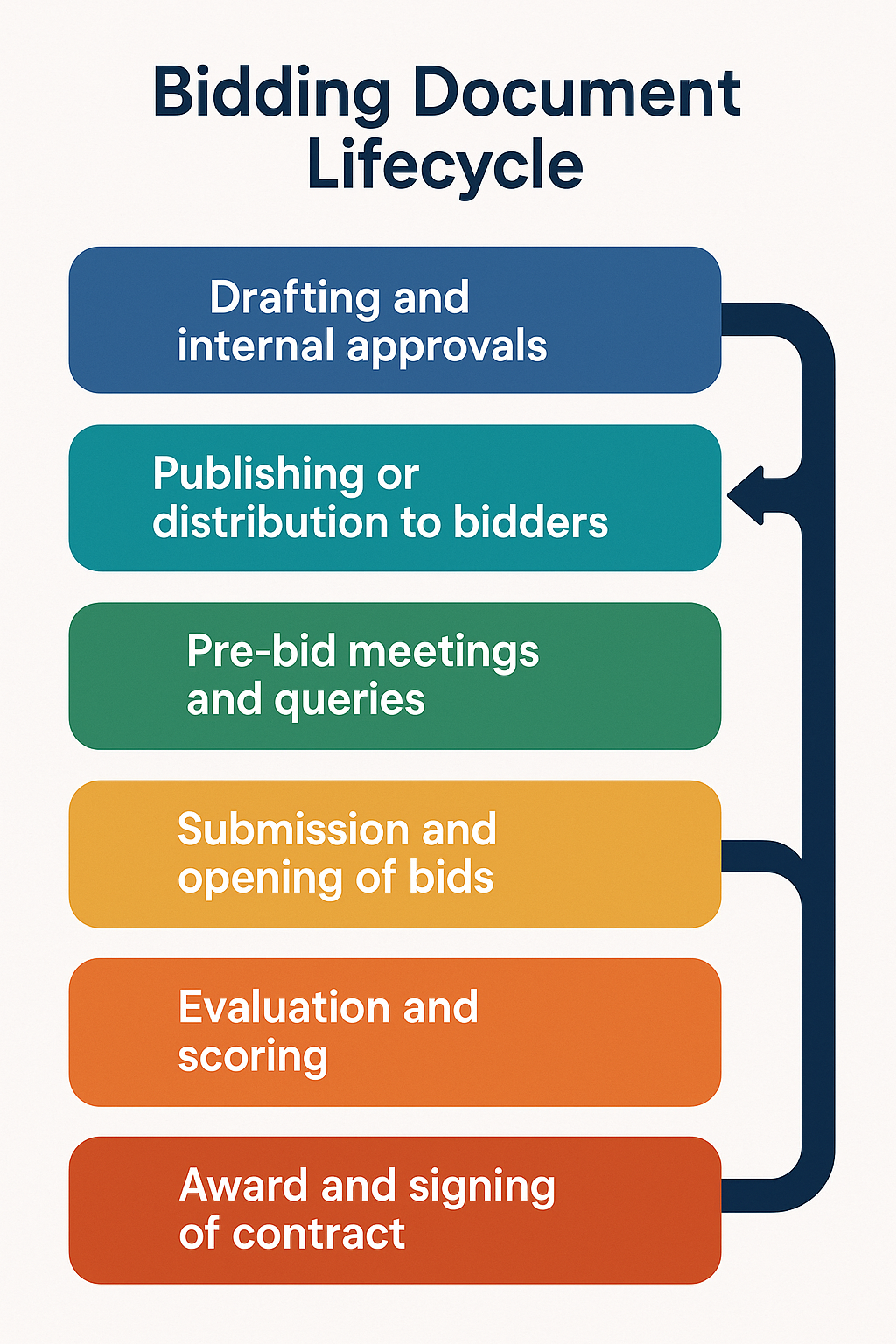In the construction industry, the bid process acts as the backbone of fair project procurement. Crafting and administering bidding documents with precision is vital not merely for compliance but for promoting transparency, fostering competition, and ensuring integrity in awarding contracts.
This guide illustrates the essential bidding documents, explains their purpose, and outlines best practices for their formulation and submission, ultimately leading the way for successful project execution.
Key Points
- Bidding documents are foundational tools in procurement, detailing scope, technical requirements, terms, and submission guidelines.
- There are multiple types: open, selective, limited, and negotiated.
- A well-structured bidding document promotes fair competition, legal compliance, and project clarity.
- Common pitfalls include unclear language, missing evaluation criteria, and inconsistent sections.
- Strategic bidding means aligning proposals with client goals.
- Digitalization (e.g., eProcurement, AI tools, blockchain) is reshaping how bidding is managed and evaluated.
- Industry-specific requirements especially in construction, IT, and pharmaceuticals demand precise customization.
- Legal compliance is critical. Violations can void entire bidding processes or contracts.
What are Bidding Documents in Construction?
Bidding documents are the foundation of any procurement process. They outline the requirements, legal expectations, technical details, and financial boundaries involved in public or private contracts. Whether for a multimillion-dollar construction contract or a software licensing agreement, these documents act as a legally binding roadmap that governs the transaction.
Why Bidding Documents Matter in Procurement
Bidding documents influence outcomes before any work begins. A well-structured document can encourage competitive pricing, enhance transparency, and ensure regulatory compliance.
They:
- Define project scope with absolute clarity.
- Establish fair competitive ground for all bidders.
- Protect owners and contractors from legal ambiguities.
Core Components of a Bidding Document
Every component is important and serves a specific purpose. Here are:
Invitation to Tender (ITT)
The Invitation to Tender serves as the initial document dispatched to prospective bidders, signaling the commencement of the tendering journey. More than a mere notice, it encapsulates a comprehensive synopsis of the project, describe submission protocols, key deadlines, and evaluation criteria. The ITT not only establishes procedural expectations but also sets the strategic tone of the entire procurement exercise.
Instructions to Bidders
This document operates as the procedural details for all participants. It provides a complete roadmap for bid preparation covering document formatting, submission logistics, mandatory enclosures, and bespoke directives. The aim is to harmonize submissions, thereby enabling a uniform and equitable basis for bid analysis and decision.
Bill of Quantities (BOQ)
The BOQ is an full list of every element; material, labor, and services necessary for project realization. It specifies quantities, technical parameters, and classifications. By standardizing this data, the BOQ facilitates precise cost estimation and guarantees that all participants operate from an identical informational foundation, mitigating disparities in bidding.
Technical Specifications
These specifications are the technical constitution of the project. They offer descriptions of the required workmanship, material properties, and performance benchmarks. This document ensures that bidders grasp the qualitative thresholds they must meet or exceed, minimizing uncertainity.
Drawings and Plans
These visual schematics are architectural blueprints that illustrate the spatial and dimensional fabric of the project. Including structural, mechanical, and architectural diagrams, they serve as critical reference tools that allow bidders to assume practical implementation. Detailed drawings enable contractors to understand challenges and tailor their submissions accordingly.
Form of Tender
This formal document contains the bidder’s definitive offer to handle the project. It includes identity particulars, financial proposals, and an affirmation of compliance with all tender requirements. It transforms a bidder’s interest into a legally recognized commitment to execute the scope under the defined contractual policy.
Conditions of Contract
This legal paper explains the guidance of the entire project lifecycle. It contains clauses concerning payment terms, project timelines, scope alterations, conflict resolution procedure, and termination protocols. It creates a legally binding ensuring accountability from all parties involved.
Prequalification Questionnaire (PQQ)
The PQQ functions as a preliminary filtering instrument. It explore financial health, historical performance, technical capability, legal and regulatory compliance. It shortlist the credible contenders, safeguarding the project from unqualified participation.
Schedule of Works
It outlines each phase’s initiation and conclusion, allocates durations to crucial milestones, and offers a framework for progress tracking. For bidders, it provides insight into expected resource mobilization and logistical speed, forming a basis for scheduling and cost projections.
Bidding Document Lifecycle
From planning to award, the lifecycle follows these phases. Each stage requires strict documentation and transparency, especially in public procurement.
- Drafting and internal approvals
- Publishing or distribution to bidders
- Pre-bid meetings and queries
- Submission and opening of bids
- Evaluation and scoring
- Award and signing of contract

Role of Digitalization in Bidding Documents
The digital transformation has revolutionized how bidding documents are created, distributed, and evaluated. These innovations reduce fraud, improve efficiency, and increase participation especially for remote or underrepresented vendors. Key changes are eProcurement platforms, AI-powered bid, blockchain-backed timestamping and cloud collaboration.
Industry-Specific Considerations
Construction
Site drawings, BOQs (Bills of Quantities), and safety protocols are crucial. Misestimating costs here leads to project delays and budget overruns.
Pharmaceuticals
Regulatory compliance with drug laws, temperature-controlled logistics, and expiry terms must be documented with precision.
IT & Software
Service-level agreements (SLAs), licensing structures, data protection clauses, and cybersecurity standards form the backbone.
Common Pitfalls to Avoid in Bidding Document Preparation
Avoid these costly errors:
- Ambiguous scope definitions
- Contradictory technical and legal sections
- Unrealistic timelines
- Absence of evaluation criteria
- Vague dispute resolution clauses
- Neglecting these can lead to legal battles, failed projects, or procurement blacklisting.
Final Thoughts
Bidding documents aren’t just administrative paperwork. They are strategic ways that determine the flow, fairness, and success of procurement processes. Crafting or responding to these documents requires clarity, compliance, and strategic foresight. Whether you’re a contractor, consultant, or project manager, mastering the nuances of bidding documents opens doors to opportunity and growth.
